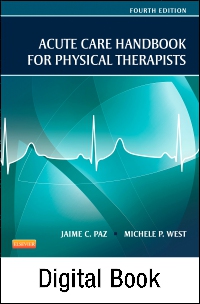
Acute Care Handbook for Physical Therapists- Elsevier eBook on VitalSource, 4th Edition
Elsevier eBook on VitalSource

Familiarize your students with the acute care environment so they can confidently develop patient rehabilitation plans. Acute Care Handbook for Physical Therapists, 4th Edition helps your students understand and interpret hospital protocol, safety, medical-surgical ‘lingo’, and the many aspects of patient care from the emergency department to the intensive care unit to the general ward. This restructured new edition streamlines the text into four parts— Introduction, Systems, Diagnoses, and Interventions to make the book even easier to use as a quick reference. Intervention algorithms, updated illustrations, and language consistent with the ICF model all help your students digest new information and become familiar with new terminology. This comprehensive resource is just what your students need to better manage the specific needs of their patients in the complex acute care environment.
Newer Edition Available
Acute Care Handbook for Physical Therapists Elsevier eBook on VitalSource
-
- NEW! Restructured table of contents helps your students quickly locate information.
- NEW! Language from the International Classification of Functioning, Disability, and Health (ICF) model adopted by the American Physical Therapy Association increases your students’ familiarity with terminology.
- NEW! New intervention algorithms along with existing algorithms break clinical decision-making into individual steps and sharpens on-the-spot critical-thinking skills.
- NEW! A quick-reference appendix covering abbreviations commonly found in the acute care environment supplies the translation tools students need, while flagging any abbreviations that may be harmful to the patient.
- Intervention algorithms, tables, boxes, and clinical tips highlight key information about the acute care environment in a format that makes finding and digesting information easy.
- The major body system chapters provide the evidence-based information your students need to understand the complex issues of patients in the acute care environment so they can optimally manage the needs of their patients.
- Current information on medications, laboratory tests, diagnostics, and intervention methods relevant to patients in the acute care environment illustrates how the acute care environment can impact these elements.
- Clinical tips highlight key points and provide access to the tips and tricks accumulated over a career by an experienced clinician.
- Language consistent with the Guide to Physical Therapist Practice, 2nd Edition offers common linguistic ground through the use of Guide standards.
- Lay-flat pages and uncluttered design make the book easier to use as a quick reference.
-
- NEW! Restructured table of contents helps you quickly locate information.
- NEW! Language from the International Classification of Functioning, Disability, and Health (ICF) model adopted by the American Physical Therapy Association increases your familiarity with terminology.
- NEW! New intervention algorithms along with existing algorithms break clinical decision-making into individual steps and sharpens your on-the-spot critical-thinking skills.
- NEW! A quick-reference appendix covering abbreviations commonly found in the acute care environment supplies the translation tools you need, while flagging any abbreviations that may be harmful to the patient.
-
Part 1: Introduction
1. The Acute Care Setting
2. The Medical RecordPart 2: Systems
3. Cardiac System
4. Respiratory System
5. Musculoskeletal System
Appendix:Management and Physical Therapy Interventions for Fractures
6. Nervous System
7. Vascular System and Hematology
8. Gastrointestinal System
9. Genitourinary System
10. Endocrine SystemPart 3: Diagnoses
11. Oncology
12. Burns and Wounds
13. Infectious Diseases
Appendix: Disorders of Altered Immunity
14. Organ Transplantation
15. Fluid and Electrolyte Imbalances
16. Amputation
17. Physical Therapy Considerations for Patients who Complain of Chest PainPart 4: Interventions
18. Medical-Surgical Equipment in the Acute Care Setting
Appendix: Mechanical Ventilation
Appendix: Circulatory Assist Devices
19. Pharmacologic Agents
20. Anesthesia: Perioperative and Postoperative Considerations
21. Pain Management
22. Postural Drainage
23. Functional Tests


 as described in our
as described in our 